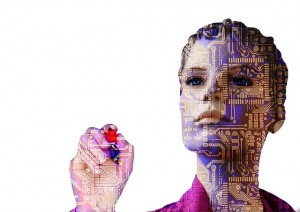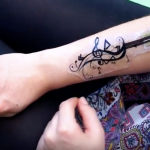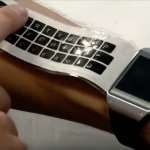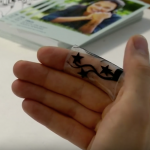Don’t be afraid of robots – be afraid that you become one!
 Our fantasies about becoming cyborgs are getting ever closer to reality. We have been creating robots and software to do work for us. And now we are on the best way to become robots ourselves. A new achievement in science is getting us another step closer to that scenario. Let me introduce you to iSkin, a skin-worn sensor that turns the human body into a touch sensitive surface. This gadget not just allows us to use our technical devices without touching them but makes it possible to wear them literally as a second skin.
Our fantasies about becoming cyborgs are getting ever closer to reality. We have been creating robots and software to do work for us. And now we are on the best way to become robots ourselves. A new achievement in science is getting us another step closer to that scenario. Let me introduce you to iSkin, a skin-worn sensor that turns the human body into a touch sensitive surface. This gadget not just allows us to use our technical devices without touching them but makes it possible to wear them literally as a second skin.
iSkin: flexible, stretchable and visually customizable
iSkin is a skin-worn sensor that turns the human body into a touch sensitive surface to control mobile devices.
Scientists who developed iSkin at the Max-Planck Institute for Informatics in Germany claim it to be the first investigation into how electronic skin can be used for body interactions to control mobile computing devices, including interactive scenarios, sensing techniques, form factors and device types as well as aesthetics. Advances in electronic skin and materials science allowed the scientists to explore a new application domain: on-body interaction for mobile computing. iSkin is the first investigation into this domain for the field of human computer interaction.
The material itself is made from biocompatible silicone rubber with pressure-sensitive sensors that are stuck to the skin of the users, allowing them to use their own body to control mobile devices. The sensor is capable of detecting touch input pressure even when being stretched or bent. With these contributions, iSkin enables a completely new type of on-body devices. It can be produced in different shapes and sizes to suit various locations of the body such as the finger, forearm, or ear. With the current prototype answering incoming calls, playing music and even adjusting the volume becomes possible. Furthermore a roll-up keyboard is being designed that can be used with a smart watch.
- An input surface for a music player (Reuters, youtube.com)
- A rollout keyboard attached to a smart watch (Reuters, youtube.com)
- FingerStrap for fast, one-handed control of incoming calls (Reuters, youtube.com)
On-body interaction offering new possibilities
Its unique properties open up new capabilities for mobile interaction that have not been possible with existing hardware. It allows for fast and direct control of mobile devices using touch input even when the hands are busy.
“Current electronics are mostly using rigid components which are very uncomfortable to wear on the body and are limiting the locations to, for example, the wrist or on the head to be worn. But our sensor is a flexible and stretchable sensor, so it can cover many locations. For example, even the backside of the ear or the forearm. So, we have a much larger input space than current electronics allow for,” co-developer Martin Weigel
Although the current prototypes are wired to a computer, the developers are optimistic that the technology could evolve to using integrated microchips or making it wireless by using ad-hoc networks for communication with other body-worn devices. Furthermore the team is looking into using kinetic energy from the body to power iSkin.
One step further into living in a “digital bubble”
While the developers have no immediate plans to develop this iSkin prototype further, the team hopes it will inspire future research. And it certainly will. Even though iSkin is not available in the stores yet, it is a big step into a completely new dimension.
We are already committing our whole live to machines. Whether it comes to our laptops at work or our smartphones in our free time. We are constantly online and we are giving all decisions and actions into techniques’ hands from online banking to online dating. If the trend continues we will soon all be connected 24/7 from the inside and out, emitting streams of data on our heart rate, sleep patterns, steps taken and sex behavior. And once we can use our electronic devices on our skin without even taking action in using the actual gadget we will literally merge with the technical devices we use.
Wearable devices will become ubiquitous – some day
The bad – or maybe the good news is that the hype is years ahead of the market. Big and unresolved questions remain about pricing, battery, utility, aesthetics and of course privacy issues.
“… three months [after buying a wearable device] only 40% of people still wear these things,” estimates Chander Chawla, a tech consultant who has advised scores of venture capitalists and manufacturers on bringing wearables to market. But the potential for this thin, soft, flexible form factor is however absolutely huge. Maybe we ware not yet ready for the big change, but it is sure that it will come. And considering that we are all part of this global and digital network we will become more transparent and mechanized with every single new technological innovation. The question left to pose is if we are going to be digitized humans or humanized machines?
References:
Charara, Sophie. “iSkin lets you control your smartphone via electronic skin sensors”. Wearable.com. 11. August 2015. 08. September 2015.
http://www.wareable.com/wearable-tech/iskin-control-smartphone-electronic-skin-sensors-1512
Embodied Interaction. 2015. Max Planck Institute for Informatics. 09. September 2015.
https://embodied.mpi-inf.mpg.de
Guglielmo, Connie. “The Case Against Wearables, Or Why We Won’t All Look Like The Borg This Year“. Forbes.com. 12. February 2014. 10. September 2015.
http://www.forbes.com/sites/connieguglielmo/2014/02/12/the-case-against-wearables/
Reuters. “Electronic skin sensors to control mobile gadgets“. Youtube.com. 10. August 2015. 10. September 2015.
https://www.youtube.com/watch?v=CgXRP05U6DM
Stock, Matthew. “Electric Sensors Let You Use Your Phone By Touching Your Skin“. Huffingtonpost.com. 10. August 2015. 09. September 2015.
http://www.huffingtonpost.com/entry/electric-sensors-let-you-use-your-phone-by-touching-your-skin_55c8e72de4b0f1cbf1e5c2f6?utm_hp_ref=our-connected-future
Weigel, Lu, Bailly, Oulasvirta, Majidi and Steimle. “iSkin: Flexible, Stretchable and Visually Customizable On-Body Touch Sensors for Mobile Computing”. Proceedings of the SIGCHI Conference on Human Factors in Computing Systems (CHI ’15). 2015. 10. September 2015.
https://embodied.mpi-inf.mpg.de/files/2015/01/2015-iSkin.pdf


